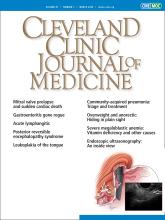The case report and literature review by Rastogi and Rome in this issue1 reminds us that eating disorders can occur in patients with a wide variety of weights and that those who were previously overweight present differently from those with classic anorexia nervosa. The case presented meets the Diagnostic and Statistical Manual of Mental Disorders, Fifth Edition (DSM-5) criteria for atypical anorexia nervosa, which describes patients who have lost a significant amount of weight but whose weight remains in the normal or above-normal range.2
See related article, page 165
Before the DSM-5 was published, most children, adolescents, and young adults seeking treatment at specialized eating disorder programs who did not meet the criteria for either anorexia nervosa or bulimia nervosa were assigned the diagnosis of “eating disorder not otherwise specified” (EDNOS).3 Revisions have since been made to the diagnostic criteria in DSM-5 to improve the clinical utility of the diagnostic categories. The EDNOS diagnosis has been eliminated and new diagnostic categories have been introduced, including atypical anorexia nervosa.
The proportion of patients with atypical anorexia nervosa in specialized eating disorder programs has increased dramatically, often accounting for 25% to 40% of patients admitted to inpatient units. The number of these patients presenting to one tertiary care inpatient service increased 5-fold over a period of 5 years.4
PROBLEMS WITH CUTOFFS
“Low body weight” has always been a key clinical feature of anorexia nervosa, but what constitutes low body weight in adolescents remains problematic. In the DSM-IV, the suggested weight cutoff of less than 85% of expected body weight meant that a patient with all the features of anorexia nervosa but with a higher body weight would not meet the diagnostic criteria.
Although body mass index (BMI) cutoffs are useful in determining low weight in adults, determining low weight is challenging in children and adolescents who are undergoing rapid changes in height, weight, body composition, and fat distribution associated with normal growth and development. Absolute BMI cannot be used. A BMI of 17 kg/m2 would be low for an adult woman but would be normal for a 13-year-old female adolescent.
In addition, the methods used to determine expected body weight during adolescence vary widely.5 In DSM-5, the diagnosis of anorexia nervosa requires restriction of energy intake relative to requirements, leading to a significantly low body weight in the context of age, sex, developmental trajectory, and physical health.2 While no specific weight cutoff is included, a BMI lower than the 5th percentile suggests underweight. It is understood, though, that children and adolescents with a BMI above this percentile could still be underweight if they fail to maintain their expected growth trajectory.2
ATYPICAL ANOREXIA NERVOSA HAS CONSEQUENCES
Compared with those who have anorexia nervosa, patients with atypical anorexia nervosa usually present for treatment after a longer duration of illness6 and are less likely to receive inpatient care,7 suggesting that the seriousness of their illness is not recognized because of their normal weight. Yet patients with atypical anorexia nervosa can be just as medically ill as their peers with anorexia nervosa and can have even greater eating disorder psychopathology.8,9
While it is well recognized that no body system is immune from the medical complications of restricting eating disorders, what is now emerging is an understanding that some of these same complications occur in patients with weight suppression (ie, who lose a lot of weight, regardless of whether they end up underweight). Specifically, from a cardiac standpoint, marked bradycardia, hypotension, and pulse nadir have been described. Although these cardiac findings resolve with nutritional rehabilitation and their long-term significance is not yet known, it is noteworthy that they can occur even when the absolute current weight is not low by traditional standards.
Moreover, with emerging evidence suggesting that bradyarrhythmias may be causal in the increased risk of sudden death in patients with anorexia nervosa, the finding of marked bradycardia in patients with atypical anorexia nervosa is noteworthy.10
In addition, and frankly surprising, the highly prevalent and perhaps permanent loss of bone mineral density present in anorexia nervosa also seems to adversely affect patients with the atypical form. The etiologic reasons for this are unclear because the many purported factors that cause loss of bone mineral density in anorexia nervosa would not be expected to be present in patients with atypical anorexia nervosa, including elevated cortisol levels, abnormalities of growth hormone and insulin-like growth factor 1, and sarcopenia. But clearly, neurohormonal aberrations are involved in the amenorrhea of patients with atypical anorexia nervosa as enumerated by Rastogi and Rome,1 and these may indeed start the process toward osteopenia and osteoporosis.
REFEEDING HYPOPHOSPHATEMIA
An additional area of potential concern arises during the initial phases of refeeding of those with marked weight suppression. The need for assiduous follow-up of serum phosphorus during the early stages of refeeding to screen for refeeding hypophosphatemia has long been part of weight restoration in anorexia nervosa. The anabolic processes that are activated and the need for phosphorus to drive the production of high-energy compounds such as adenosine triphosphate are operative and well-accepted to avoid the dangerous refeeding syndrome.
What is unexpected is this problem in the early phases of nutritional rehabilitation of those who have atypical anorexia nervosa. Refeeding hypophosphatemia has been noted anecdotally in patients with atypical anorexia nervosa. This common complication of refeeding is relevant not only to those with low absolute body weight; it can also occur in those with marked weight suppression who are being judiciously refed early in their recovery.
NOT JUST WEIGHT, BUT ALSO WEIGHT LOSS DETERMINES SEVERITY
The timely review by Rastogi and Rome1 reminds readers that not only absolute weight but also weight suppression (the difference between highest weight and presentation weight) and the rapidity of weight loss determine disease severity, medical complications, and the treatment outcome in this emerging area along the spectrum of eating disorders.9–12
- Copyright © 2020 The Cleveland Clinic Foundation. All Rights Reserved.






